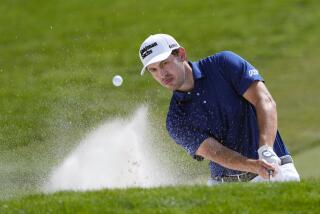He’s at Home on the Range or Course : Golf: Besides being a popular teaching pro at Saddleback, Alan Tapie is working on a return to competitive play.
MISSION VIEJO — All eyes turned to Alan Tapie when it came time to put on a demonstration of golf skills for the dignitaries gathered at the opening of the Saddleback College driving range.
Tapie, a member of the Professional Golf Assn., had been asked to hit a few shots at the range’s inauguration last March.
Bill Cunerty, Saddleback’s golf coach, first asked Tapie to hit a shot with a high fade, toward a marker about 170 yards away.
Tapie, 44, delivered with the precision that allowed him to be a competitive member of the PGA Tour for almost 10 years.
Next, Cunerty asked for a low hook.
Tapie again delivered, landing the ball within a few yards of his target.
Finally, Cunerty asked for a shot to the artificial green about 100 yards away.
Tapie lofted a shot that nearly rolled in the hole and ended up only a few feet past it as the gathering gasped, then broke into loud applause.
But Tapie wasn’t there just to put on a demonstration, he was also trying to drum up some clients for the range that features two ends, one for the public and another for college classes.
Tapie is the head of instruction at the public end of the range, which has flourished from the outset.
Tapie, who had been teaching off and on for the last 10 years, worked as an instructor at the driving range in Laguna Hills before moving to Saddleback.
Besides teaching, Tapie also has continued to play and has shot some impressive scores around the area. He had a nine-under-par 62 at Mesa Verde County Club in Costa Mesa. He also has rounds of seven-under 65 at Coto de Caza Golf and Racquet Club and a seven-under 63 at Marbella Golf and Country Club in San Juan Capistrano.
Tapie has quickly built a strong following in a short time at Saddleback, and his success is no surprise to Cunerty.
“We started with the idea that we wanted a Class-A PGA pro teaching at the other end,” Cunerty said. “He’s a great guy and a marvelous teacher. He’s not one of these swing gurus who get popular because they’re aligned with a touring pro but later die out. He wouldn’t want that.
“It’s not what you know, it’s how much you can get across to people. Alan has a gift for that.”
Tapie’s approach to teaching centers mostly on the basics, starting with the stance and grip and going right through the entire swing.
“Most people aren’t fundamentally sound in their swings,” he said. “You have to first access their capabilities, find out their goals and how much time they have to play and practice. . . . There’s no substitute for that.”
Besides teaching, Tapie is also spending a good deal of time working on his swing in an effort to return to competitive play on a selective basis.
About three months ago, he started working in Palm Springs with Mac O’Grady, a part-time tour player considered by many as one of the better teachers working today.
O’Grady is the first coach Tapie has worked with regularly. As a result, Tapie is making major changes in his swing path for the first time since he started playing at about age 12.
“I believe (O’Grady) is probably the most knowledgeable person on the planet about the golf swing,” Tapie said. “Golf is not a simple endeavor. It’s very misleading. It’s very complicated, but you have to try and keep it simple.”
Tapie showed promise almost as soon as he started playing, but he was more interested in baseball and football while in junior high and at Warren High in Downey.
He was a standout pitcher and only played for the golf team when there wasn’t a scheduling conflict. But an injury to his right elbow required surgery his junior year, and he was limited to playing the outfield as a senior.
He went to Cerritos College and played on the golf team in 1968-69, winning the the South Coast Conference individual title as a sophomore.
He earned a scholarship to USC. And after two strong seasons with the Trojans, he turned professional in 1972.
He made it through the Tour’s qualifying school in 1974 and started playing full time in ’75.
He had 22 Top 0 finishes, was in the Top 25 in five majors and earned more than $500,000 in his career. In 1981, he averaged 28.70 putts a round, best on tour.
His best financial year came in 1979, when he won almost $90,000. He quit playing the Tour full time in 1985 because of “family obligations.” He started teaching in an effort to stay close to the game.
But he would like the chance to play again part time, maybe in Europe.
“I still want to get back into competitive golf,” Tapie said. “But I want to continue to build my business here as well. I guess I want the best of both worlds. I want to compete against some of the best golfers in the world, but I just don’t want to depend on it for a living.”
More to Read
Go beyond the scoreboard
Get the latest on L.A.'s teams in the daily Sports Report newsletter.
You may occasionally receive promotional content from the Los Angeles Times.










